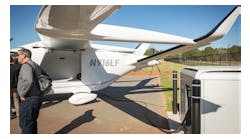ACPA Names Recipients of 2018 'Excellence in Concrete Pavements' Awards
The American Concrete Pavement Association (ACPA) has named recipients of its 29th Annual “Excellence in Concrete Pavements” awards, which recognize quality concrete pavements constructed in the United States and Canada. The awards program encourages high-quality workmanship, quality, and creativity in concrete pavement projects.
The award-winning projects were paved by 22 different contractors. Projects are located in 13 states or regions represented by ACPA-affiliated Chapters and State paving associations. Winners were determined by 40 professionals who devoted their time and expertise to serve as judges.
The program recognizes contractors, engineers, and project owners who completed outstanding projects. Award recipients are:
Reliever & General Aviation Airports
(Silver Award) Lee’s Summit Municipal Airport
Contractor: Emery Sapp & Sons Inc.
Owner: City of Lee’s Summit (MO)
Engineer: Crawford, Murphy & Tilly
This is a story about the reconstruction of Lee's Summit Municipal Airport, but it’s also about much more. It’s about the importance of the airport to travelers and existing businesses, as well the airport’s value in attracting and retaining news businesses.
The project consisted of the complete reconstruction and extension of runway 18/36 from 4,200 linear ft to 5,501 linear ft, as well as the extension of runway 11/29 from 3,800 linear ft to 4,000 linear ft. In addition to increasing the overall runway length, the airport also elected to replace airfield lighting as well as increase the pavement thickness from 6 in. to 9 in., which increased capacity from a 30,000 lb. rating to a 60,000 lb. rating.
The contractor, Emery Sapp & Sons was scheduled to start this work at the beginning of April, but spring rains delayed the start. When the contractor was cleared to start, the crews worked around the clock to meet the aggressive completion timeline. Even though the rains persisted, the contractor still opened the runway within the 21-day requirement.
The second was the construction of the North and South portions of Runway 18/36 which was to be completed within a 182-day closure of Runway 18/36. The contractor completed the second phase in under 70 days, which allowed ample time for all remaining work to be completed prior to reopening the
runway.
In all, the contractor paved 72,375 SY of concrete paving for a total project length of just over a mile or the equivalent of about 4 lane miles, and now the City and the region can boast of an airport that can meet the current and long-term needs of travelers and businesses alike.
(Gold Award) Sioux Falls Regional Airport 2017 Reconstruction
Contractor: T&R Contracting, Inc.
Owner: Sioux Falls Regional Airport
Engineer: KLJ
Carefully planned and executed construction staging is important for any airport project, but it was particularly important considering the scale of the reconstruction and rehabilitation project at Sioux Falls Regional Airport, which is home to the South Dakota Air National Guard’s F-16, “Fighting Falcon” jets.
The project consisted of the partial reconstruction of runway 3/21; partial reconstruction of taxiways A, B4, and B5; rehabilitation of taxiway K rehabilitation; reconstruction of the aircraft arresting system on runway 3/21; and the partial reconstruction of National Guard Drive.
The first phase consisted of the reconstruction of taxiways K and B5, as well as the demo, a 3.5 ft subgrade cut, and placing gravel for 800 feet for runway 3/21 and taxiway B4. The two taxiways had to be completed before T&R Contracting could close the rest of the runway and taxiway A to allow for planes to taxi on K and B5.
The second phase consisted of the remaining demo, grading and placing gravel for runway 3-21, along with work on taxiway A. This work included removing 30-in. thick asphalt and a 3.5 ft subgrade
cut, placing a 17-in. thick concrete paving on runway 3/21 and taxiway A, and adding 30 ft.-wide asphalt shoulders. All this work had to be completed in 70 calendar days.
Both phases included a four-step installation of lights, which involved pouring a base and paving over it, adding a 14 in. diameter core, adding an upper section, and then epoxying. In all, there were 128 in-pavement lights that had to be sequenced appropriately to allow room for the paver track and access by the concrete trucks to the paver.
After paving the runway, a 5 ft x 150 x 17 in.-thick section of new paving had to be sawed out for the construction of the Aircraft Arresting System, which serves as the emergency braking system for the F-16 jets.
Another notable detail about the project was the contractor demonstrated a commitment to sustainable construction by in situ recycling of the existing 15-in. concrete paving and reuse of the material for the 13-in. base.
The scope of the project, the schedule, and the other challenges proved to be no match for the contractor, which counted this project as the latest in their on-time, successful projects delivered for the airport in recent years.
Commercial Service & Military Airports
(Silver Award) Runway 13/31 Reconstruction – Phase I, Topeka/Shawnee Co, KS
Contractor: Emery Sapp & Sons Inc.
Owner: Metropolitan Topeka Airport Authority
Engineer: WSP
The Topeka Regional Airport has been in service since the time of World War II, so when it was time to replace the main runway and perform other upgrades, the owner specified concrete.
Originally built as a military base and later expanded to service both commercial and private air traffic, as well as both the Kansas Air National Guard and Army National Guard. The main runway (13/31) has been in use for many decades utilizing the original concrete pavement. In addition to needing new pavement with stabilized subgrade and a drainable base and under-drain system, the facility also needed upgrades including new runway lighting and signage; updated navigational aids; an improved profile and geometry.
The contractor, Emery Sapp & Sons, Inc. had the challenge of replacing the runway while maintaining military and commercial air traffic. The project was divided into two phases to be constructed over
two years.
Phase 1, an $18 million project, was started in February 2017 and completed in October 2017. Emery Sapp crews completely removed 6,500 feet of main runway and replaced with 16.5 in. doweled JCPC pavement. The project also involved removing 154,000 SY of existing runway and taxiway; grading more than 265,000 CY; placing 123,000 SY of lime treated subgrade; and placing 54,000 CY of concrete and 20,000 CY of cement-treated permeable base. Additional features include over 18,000 LF of under drain, a new lighting and navigational system, new pavement markings.
The mix designs for both the concrete and cement-treated permeable base used granite and trap rock to increase the durability of the final product and potentially extend the life of the pavement. Fly ash was also added to the mixture to mitigate ASR and create a denser mixture.
This project was completed on time and under budget, with no accidents or safety-related incidents.
Also, as a testament of the quality of the product, it should be noted that more than 112,000 SY of concrete pavement were placed with corrective actions needed. With an average smoothness index of just over a 0.50 in. per mile, this smooth, durable pavement is expected to provide service for decades to come
(Gold Award) Taxiway Pavement Replacement at Hartsfield-Jackson Atlanta International Airport,
Atlanta, GA
Contractor: McCarthy Improvement Company
Owner: Hartsfield-Jackson-Atlanta International Airport
Engineer: Atkins
Completing any construction project at the world’s busiest airport would be a challenge, but when ATL airport needed three taxiways and adjacent shoulders replaced, McCarthy Improvement Company met the challenges by delivering a quality concrete pavement reconstruction project.
The total contract was $23.7 million, with the concrete portion accounting for more than $5.1 million. In all, the work was completed in 10 phases. The overall project duration was 330 calendar days, with liquidated damages set at $100/minute for any delays in reopening taxiways as specified, as well as $3,000/day penalties for exceeding the 330-day schedule.
The demo sections depth varied from 16.75 in. to 22 in. During one phase of the demolition, crews found and removed two layers of concrete with strength at or above 3,000 psi.
The taxiway pavement replacement project consisted of full depth replacement of portions of three taxiways. In all, the work included 38,000 SY of concrete paving removal, new centerline lights, subgrade repairs, new underdrain system, and a complete rebuilding of asphalt shoulders.
The typical new taxiway section was comprised of new underdrains trunk lines and herring bones, new light can conduits & light cans, a P-401 bituminous leveling course on top of 6 in. of soil cement, fully rebuilt asphalt shoulders, and a 20 in. concrete pavement. The non-reinforced/reinforced concrete thicknesses were: 20 in., 20 to 26 in. thickened edges, and 16 to 20 in., and a 16 in. shoulder ramp.
Typical slab sizes were 25 ft x 25 ft, with two of the phases having outside slabs measuring 12.5 ft wide 25 ft long. The smaller slabs were reinforced, slip-formed, and extended for a total length of approx. 900 linear ft in one phase and 725 linear ft in another.
The required straight-edge smoothness was 12 in., with a maximum 0.25 in. deviation on 16 ft with anything over 0.5 in. removed and replaced. Despite the presence of new light cans installed in the center-line lanes, as well as intersecting taxiways, the concrete met the smoothness requirements with no grinding.
One of the keys to the successful completion of this project was the extensive planning and coordination, which ensured all the construction traffic and related operations were contained in the designated work area, thereby avoiding the disruption of airport operations. Haul routes were clearly marked on drawings provided to escorts and haul-truck drivers.
Scheduling was done for each hour of every 24-hour workday, which was divided into 12-hour shifts, with a 1-hour overlap for the crews. The project also benefited from strong support by the owner and engineer, along with real-time decision making to address unforeseen conditions, along with the contractor’s ability to adjust operations efficiently.
Expert planning, communications, and paving resulted in this project being completed on time. Thanks to this team effort, the three durable, concrete taxiways can be expected to meet the demands of this busy and bustling airport for many years to come.

